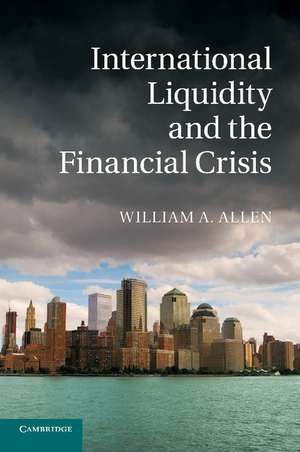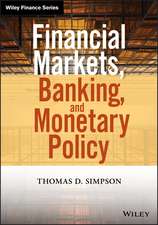International Liquidity and the Financial Crisis
Autor William A. Allenen Limba Engleză Paperback – 2 apr 2014
| Toate formatele și edițiile | Preț | Express |
|---|---|---|
| Paperback (1) | 334.19 lei 6-8 săpt. | |
| Cambridge University Press – 2 apr 2014 | 334.19 lei 6-8 săpt. | |
| Hardback (1) | 724.77 lei 6-8 săpt. | |
| Cambridge University Press – 2 ian 2013 | 724.77 lei 6-8 săpt. |
Preț: 334.19 lei
Nou
Puncte Express: 501
Preț estimativ în valută:
63.95€ • 69.45$ • 53.72£
63.95€ • 69.45$ • 53.72£
Carte tipărită la comandă
Livrare economică 22 aprilie-06 mai
Preluare comenzi: 021 569.72.76
Specificații
ISBN-13: 9781107420328
ISBN-10: 1107420326
Pagini: 270
Ilustrații: 36 b/w illus. 49 tables
Dimensiuni: 152 x 229 x 14 mm
Greutate: 0.36 kg
Editura: Cambridge University Press
Colecția Cambridge University Press
Locul publicării:New York, United States
ISBN-10: 1107420326
Pagini: 270
Ilustrații: 36 b/w illus. 49 tables
Dimensiuni: 152 x 229 x 14 mm
Greutate: 0.36 kg
Editura: Cambridge University Press
Colecția Cambridge University Press
Locul publicării:New York, United States
Cuprins
1. Introduction; 2. The domestic liquidity crisis in the USA; 3. International liquidity crises outside the USA; 4. Effects on financial markets outside the USA; 5. The theory of central banking before the crisis and the practice of central banking during the crisis; 6. Swap lines; 7. Which countries received swap lines?; 8. Did the swap providers achieve their objectives?; 9. How did the swap lines affect the recipients?; 10. Propagation and scale of the 1931 crisis; 11. The management of the 1931 crisis; 12. A comparison of 1931 and 2008; 13. International liquidity management.
Recenzii
'The financial crisis that began in 2007 is a terrifying event, comparable only with the Great Depression between the world wars. Few expected it. Its effects spread almost everywhere. But it could have been so much worse. Allen's powerful new book moves from where, how and why it began, to describe and analyse the numerous things that central banks and governments around the world did to try to contain it. This volume is a well documented, highly readable must-read for everyone interested in the largely untold story of how it was that official reactions would help to prevent a really nasty crisis turning into an absolute disaster.' Peter Sinclair, University of Birmingham
'Shortage of liquidity can destroy a bank within hours; shortage of capital leads to a slow death. Yet in recent years regulators and academics have concentrated their attention on bank capital and almost ignored liquidity. In this book, Bill Allen returns to the tradition of the great writers on banking, Thornton and Bagehot, and analyzes what liquidity is, how it matters, and how neglect of it contributed to the recent crisis. This is a good and important book which manages to be both timely and of enduring worth.' Geoffrey Wood, Emeritus Professor, University of Buckingham and Emeritus Professor, Cass Business School, City University, London
'Bill Allen has written an outstanding, lucid account of the financial crisis and international liquidity flows. He shows how central banks responded to the crisis and makes a telling comparison with the last big international financial crisis in the 1930s.' Forrest Capie, Emeritus Professor, Cass Business School, City University, London
'Bill Allen has written a very clear account of the interaction between the withdrawal of liquidity from wholesale financial markets in 2007/8/9 and the unfolding of the crisis. He attributes the relative success, compared to 1931, of the steps taken to counteract the 2008/9 crisis to the willingness of Central Banks to expand their balance sheets, with particular emphasis on the Fed's willingness to extend dollar swaps to other countries. Ben Bernanke will find this a pleasure to read; so will you, and so did I, perhaps particularly, the nice short chapter (5) on changes, under pressure, to Central Bank theories and practice.' Charles Goodhart, Emeritus Professor, London School of Economics and Political Science
'This excellent book should be required reading for all central-bank governors [and] will remain a valuable resource for economists and financial historians for many years to come.' Nicholas Crafts, The Business Economist
'Shortage of liquidity can destroy a bank within hours; shortage of capital leads to a slow death. Yet in recent years regulators and academics have concentrated their attention on bank capital and almost ignored liquidity. In this book, Bill Allen returns to the tradition of the great writers on banking, Thornton and Bagehot, and analyzes what liquidity is, how it matters, and how neglect of it contributed to the recent crisis. This is a good and important book which manages to be both timely and of enduring worth.' Geoffrey Wood, Emeritus Professor, University of Buckingham and Emeritus Professor, Cass Business School, City University, London
'Bill Allen has written an outstanding, lucid account of the financial crisis and international liquidity flows. He shows how central banks responded to the crisis and makes a telling comparison with the last big international financial crisis in the 1930s.' Forrest Capie, Emeritus Professor, Cass Business School, City University, London
'Bill Allen has written a very clear account of the interaction between the withdrawal of liquidity from wholesale financial markets in 2007/8/9 and the unfolding of the crisis. He attributes the relative success, compared to 1931, of the steps taken to counteract the 2008/9 crisis to the willingness of Central Banks to expand their balance sheets, with particular emphasis on the Fed's willingness to extend dollar swaps to other countries. Ben Bernanke will find this a pleasure to read; so will you, and so did I, perhaps particularly, the nice short chapter (5) on changes, under pressure, to Central Bank theories and practice.' Charles Goodhart, Emeritus Professor, London School of Economics and Political Science
'This excellent book should be required reading for all central-bank governors [and] will remain a valuable resource for economists and financial historians for many years to come.' Nicholas Crafts, The Business Economist
Descriere
Explains how the financial crisis spread across the world, how damage was contained and how the monetary world has changed.












